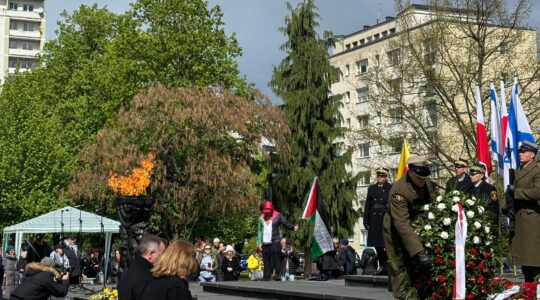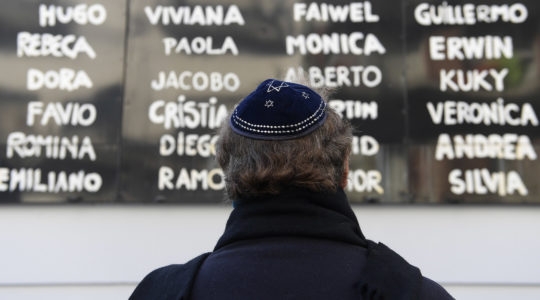
Students at ORT’s Belgrano campus in Buenos Aires interview a visiting journalist at the school’s radio studio. (ORT)
BUENOS AIRES, Argentina (JTA) — The old Citroen on the campus of one of ORT’s two schools in Buenos Aires sits stripped to a skeleton, its doors removed, dangling wires spilling out of the dashboard.
In place of the engine, a computer hard drive processes text messages that remotely perform vehicular functions like switching on the headlights. The steering wheel has been turned into the console for a video game that mimics a car’s movements; instead of a screen, players wear a virtual reality helmet. And the trunk has been refashioned with a stereo system.
Students at ORT’s Belgrano school, one of two large Jewish technical junior high and high schools run by ORT in this city, customized the car themselves.
“Our teaching philosophy is to give students the possibility of interacting with knowledge in various ways — not just through books, but also hands-on, to apply what they learn in problem solving,” said Alejandro Ferrari, director of studies at ORT’s Belgrano campus.
The Citroen lab is one of many interactive educational projects at the Belgrano and Almagro schools. There’s also a state-of-the-art music recording studio, radio station, TV studio, computer engineering facilities, industrial design rooms, software labs and an online virtual campus (campus.ort.edu.ar) — not to mention classrooms for more conventional subjects like history, literature and English (for which there are also interactive programs).
The schools, whose student population is mostly but not exclusively Jewish, also have mezuzahs on the doors, synagogues and a mandatory Jewish studies curriculum.
It’s all part of a package that has made ORT’s schools in Buenos Aires among the best in Argentina — and a top draw for students and parents. The schools have generated such high interest that they attract not only students from unaffiliated Jewish families that otherwise never would consider sending their kids to a Jewish school, but also non-Jews drawn to ORT’s curriculum and facilities. Several government ministers send their children to the schools.
“We’re doing things that many second-year university students are learning to do,” said one student, Cindy. “It’s awesome.”
As Jewish communities in the United States struggle with the challenge of how to make Jewish education appealing to unengaged Jewish families, the ORT schools in Buenos Aires could serve as a model: They are pluralistic, Jewish institutions whose attractiveness lies in the extraordinary academic opportunities they provide.
Avi Gonen, director of Jewish education at ORT’s Almagro campus, says the schools act as a bulwark against assimilation. Most students come to ORT never having had any Jewish experience, he said; only about 30 percent come from Jewish primary schools.
“I came here because it was recommended by my parents and by my friends,” said Martin Polaqiewist, a student at the school who said he knew little about Judaism before coming here. “I want to know more about the Jewish way. I knew little before I came, and now I know much more.”
Jewish studies are mandatory for all students, but the classes are academic, rather than religious, in nature. Subjects include Bible, Hebrew, Jewish history and Jewish culture.
The school provides facilities for students who want to attend prayer services or eat kosher food, and students with yarmulkes mingle in the hallways with Catholic and secular Jewish students. At one of the schools, about 35 students use the synagogue daily. They are allotted 20 minutes for morning prayers.
Georgina Pecchia, 16, who is Catholic, said that she was nervous about being indoctrinated by the school’s Jewish character before she first started at ORT. She was 11, and had come to the school for its drama program.
But, Pecchia said, she quickly got over her fears. “All the teachers that teach Judaism do it very carefully,” she said. “When they talk about a topic related to Catholicism they really check the things they say.”
Paul Segal, an Orthodox Jewish father with two sons at the school and three others who are alumni, said he too was nervous when he first enrolled his kids.
“At the beginning we were afraid our kids wouldn’t feel comfortable here, but we found it was quite the opposite,” Segal said. “Their friends wanted to know about their Jewish life, so my children invited them home. Some called my sons afterward because they were interested in studying at a yeshiva.”
Segal supplemented his children’s education with yeshiva studies, but said he preferred ORT over a local yeshiva high school. “Here is an opportunity to give my kids a high-level education without diminishing their Jewish education,” he said.
Ferrari says the school’s mission — to give students the tools to transfer their knowledge to others — is a Jewish value.
In one project, a pair of ORT students developed an inexpensive “eye mouse” that enables quadriplegics to operate computers without the use of their limbs. In another, a group of teenage students taught their counterparts in a poor, rural school in Santa Fe, a province in northern Argentina, how to make bricks.
“It’s really fulfilling to see what you had in your imagination and create it with your own hands,” Alex Levinton said of his industrial design class, where students’ creations range from perfume bottles to bedside lamps. “Not many 17-year-olds get to build things.”
One ORT student recently won a programming prize from Google. Three of the four students on Argentina’s delegation to last year’s informatics Olympiads in Egypt were from ORT. And student delegates to a Microsoft gaming competition last year helped Buenos Aires win first place for programming robots with artificial intelligence; each participant won an X-Box gaming system as a reward.
School officials say 96 percent of ORT alumni graduate college and 92 percent find jobs in their fields of choice — an exceptionally high rate in a country with chronic economic problems.
Unlike Jewish schools in the United States, ORT’s schools in Buenos Aires receive some government funding — about 20 percent of their annual budget. Tuition fees cover 60 percent, and another 20 percent comes from World ORT. While the cost of tuition is high by Argentine standards — about $3,380 annually — it’s only about one-tenth the tuition fee at a top Jewish day school in New York, such as Ramaz or The Heschel School. Furthermore, about 55 percent of the ORT schools’ 7,000 students receive financial aid.
“There are rich schools for rich people and poor schools for poor people. But ORT is an excellent school for all,” said Adrian Moscovich, executive director of ORT Argentina.
Despite the relatively low cost of running the schools — $22 million annually — World ORT says the global economic crisis has stretched budgets, with scholarship requests at the schools up more than 60 percent and government funding imperiled. The situation has prompted ORT to launch a matching funds campaign in a bid to raise $8 million for its programs in Latin America.
With anti-Semitism a concern in Argentina, ORT officials say having Jewish schools in the country that benefit the larger Argentine community is a key element to safeguarding the country’s Jews. “This is the best defense for the Jews of Argentina,” said Marcelo Lewkow, director of ORT Chile and a native of Argentina.





